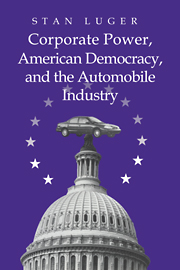Book contents
- Frontmatter
- Contents
- Acknowledgments
- Introduction
- 1 Studying Power in America
- 2 The Structure of the Auto Industry
- 3 Corporate Political Hegemony and Its Decline: 1916–1966
- 4 The Politics of Compromise: 1967–1978
- 5 The Resurgence of Corporate Power: 1979–1981
- 6 The Triumph of Corporate Power: Regulatory Policy, 1981–1988
- 7 The Triumph of Corporate Power: Trade Policy, 1981–1985
- 8 Interregnum: 1989–1996
- Conclusion: Corporate Power and American Democracy
- Index
3 - Corporate Political Hegemony and Its Decline: 1916–1966
Published online by Cambridge University Press: 08 October 2009
- Frontmatter
- Contents
- Acknowledgments
- Introduction
- 1 Studying Power in America
- 2 The Structure of the Auto Industry
- 3 Corporate Political Hegemony and Its Decline: 1916–1966
- 4 The Politics of Compromise: 1967–1978
- 5 The Resurgence of Corporate Power: 1979–1981
- 6 The Triumph of Corporate Power: Regulatory Policy, 1981–1988
- 7 The Triumph of Corporate Power: Trade Policy, 1981–1985
- 8 Interregnum: 1989–1996
- Conclusion: Corporate Power and American Democracy
- Index
Summary
Before 1966 the automobile was the only form of transportation without federal safety standards. Railroads, trucks, planes, and ships were all subject to federal regulation. At the same time, auto crashes were the leading cause of death and injury in the transportation sector, accounting for 92 percent of all deaths and 98 percent of all injuries. This anomaly was the result of efforts by auto industry officials who, seizing the initiative on safety with their superior resources, deflected attention away from the contribution of vehicle design to injuries. By being able to shape the public perception of traffic safety issues, industry officials prevented governmental scrutiny of their design decisions and preserved their managerial autonomy.
Public interest advocates, eventually led by Ralph Nader and supported by members of the medical community, ended the industry's unilateral control over vehicle design through the passage of the National Traffic and Motor Vehicle Safety Act of 1966. This concerted effort, however, was not enough to weaken the industry's political preeminence. The advent of safety regulation also required one of the most liberal Congresses in American history – the 89th, responsible for much of the Great Society legislation – as well as a series of shocking revelations concerning the industry's disregard for occupant safety. At this time, there was a growing environmental and consumer movement targeting the practices of the nation's corporations; riots, demonstrations, and protests concerning civil rights and the Vietnam War were also commonplace, all of which functioned to strengthen the hand of public interest forces.
- Type
- Chapter
- Information
- Publisher: Cambridge University PressPrint publication year: 1999



